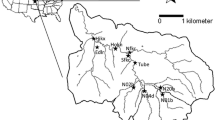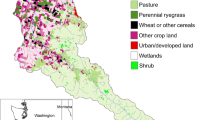Abstract
We sampled two streams in southwestern Nova Scotia from 1983 to 2004 and one stream from 1992 to 2004 for total organic carbon (TOC) and nitrogen (TN) in order to investigate if changes in catchment exports could be determined over the sampling periods, and if so what were the controlling factors. We first show that early TOC measurements underestimated concentrations due to analytical shortcomings and then produce a correction to adjust values to more accurate levels. Our trend results showed that TOC concentrations decreased in the two streams with the longest record, from 1980 to 1992 when acid deposition to the area decreased most rapidly, and have remained constant since then. TOC exports only decreased at one site over the total sampling period. As expected, we also measured seasonal changes in exports, with the autumn period showing TOC and TN exports as high as during spring snowmelt. We found that only 24% of deposition N is exported from the larger catchments, most of it in organic form, while the smallest catchment exported 16%. We also show a constant increase in TN from 1994 to the present at all three sites sampled. Our results do not support the hypothesis that reductions in sulfur acidification lead to increases in catchment organic carbon mobilization to streams.








Similar content being viewed by others
References
Ågren A, Buffam I, Jansson M, Laudon H (2007) Importance of seasonality and small streams for the landscape regulation of DOC export. J Geophys Res Biogeosciences 112:G03003. doi:10.1029/2006JG000381
Aitkenhead-Peterson JA, Alexander JE, Clair TA (2005) Dissolved organic carbon and dissolved organic nitrogen export from forested watersheds in Nova Scotia: Identifying controlling factors. Global Biogeochem Cycles 19. doi:10.1029/2004GB002438
Boyer EW, Goodale CL, Jaworski NA, Howarth RW (2002) Anthropogenic nitrogen sources and relationships to riverine nitrogen export in the northeastern U.S.A. Biogeochemistry 57/58:137–169
Brook J, Zhang L, DiGiovanni F, Padro J (1999) Modelling of dry deposition velocities for routine estimates of dry deposition across N.A. Part 1, Model development. Atmos Environ 33:5037–5051
Campbell JL, Hornbeck JW, Mitchell MJ, Adams MB, Castro MS, Driscoll CT, Kahl JS, Kochenderfer JN, Likens GE, Lynch JA, Murdoch PS, Nelson SJ, Shanley JB (2004) Input-output budgets of inorganic nitrogen for 24 forest watersheds in the northeastern United States: a review. Water Air Soil Pollut 151:373–396
Clair TA, Dennis IF, Scruton DA, Gilliss M Freshwater acidification research in Atlantic Canada: a review of results and predictions for the future. Environ Rev (in press)
Clair TA, Pollock TL, Ehrman JM (1994) Exports of carbon and nitrogen from river basins in Canada’s Atlantic Provinces. Global Biogeochem Cycles 8:441–450
Clair TA, Ehrman JM, Ouellet AJ, Brun G, Lockerbie D, Ro CU (2002) Changes in freshwater acidification trends in Canada’s Atlantic Provinces: 1983–1997. Water Air Soil Pollut 135:335–354
Clair TA, Jeffries DS (1992) Calculations of variable concentrations and exports from the Mersey River at Kejimkujik National Park in Nova Scotia. In: Willison JHM, Bondrup-Nielsen S, Drysdale C, Herman TB, Munro N, Pollock TL (eds) Science and management in protected areas. Elsevier, Amsterdam, pp 417–424
Cohn TAC, DeLong LL, Gilroy EJ, Hirsch RM, Wells DK (1989) Estimation constituent loads. Water Resour Res 25:937–942
Cronan CS, Piampano JT, Patterson HH (1999) Influence of land use and hydrology on exports of carbon and nitrogen in a Maine river basin. J Environ Qual 28:953–961
Duchesne L, Houle D (2006) Base cation cycling in a pristine watershed of the Canadian boreal forest. Biogeochemistry 78:195–216
Erman JM, Clair TA (1995) Step-wise analysis of precipitation and river chemistry trends in Atlantic Canada. Water Air Soil Pollut 85:671–676
Evans CD, Chapman PJ, Clark JM, Monteith DT, Cresser MS (2006) Alternative explanations for rising dissolved organic carbon export from organic soils- opinion. Global Change Biol 12:2044–2053
Findlay SEG (2005) Increased carbon transport in the Hudson River: unexpected consequences of nitrogen deposition? Front Ecol Environ 3:133–137
Futter MN, Butterfield D, Cosby BJ, Dillon PJ, Wade AJ, Whitehead PG (2007) Modeling the mechanisms that control in-stream dissolved organic carbon dynamics in upland and forested catchments. Water Resour Res 43:W02424. doi:02410.01029/02006WR004960
Goodale CL, Aber JD, McDowell WH (2000) The long-term effects of disturbance on organic and inorganic nitrogen export in the White Mountains, New Hampshire. Ecosystems 3:433–450
Helsel DR, Hirsch RM (1992) Statistical measurements in water research. Elsevier Sciences, Amsterdam
Hinton MJ, Schiff SL, English MC (1997) The significance of storms for the concentration and export of dissolved organic carbon from two Precambrian Shield catchments. Biogeochemistry 36:67–88
Hope D, Billett MF, Cresser MS (1994) A review of the export of carbon in river water: fluxes and processes. Environ Pollut 84:301–324
Hornberger GM, Bencala KE, McKnight DM (1994) Hydrological controls on dissolved organic carbon during snowmelt in the Snake River near Montezuma, Colorado. Biogeochemistry 25:147–165
Horne MT, Dunson WA (1995) The interactive effects of low pH, toxic metals, and DOC on a simulated temporary pond community. Environ Pollut 89:155–161
Howarth RW, Swaney DP, Boyer EW, Marino R, Jaworski N, Goodale C (2006) The influence of climate on average nitrogen export from large watersheds in the Northeastern United States. Biogeochemistry 79:163–186
Ito M, Mitchell MJ, Driscoll CT, Roy KM (2005) Nitrogen input-output budgets for lake-containing watersheds in the Adirondack region of New York. Biogeochemistry 72:283–314
Kaczmarska I, Clair TA, Ehrman JM, MacDonald SL, Lean D, Day KE (2000) The effect of UV radiation on phytoplankton populations in clear and brown temperate Canadian lakes. Limnol Oceanogr 45:651–663
Koprivnjak JF, Blanchette JG, Bourbonniere RA, Clair TA, Heyes A, Lum KR, McRae R, Moore TR (1995) The underestimation of concentrations of dissolved organic carbon in freshwaters. Water Res 29:91–94
Laudon H, Clair TA, Hemond HF (2002). Long-term response in episodic acidification to declining SO42- deposition in two streams in Nova Scotia. Hydrol Earth Syst Sci 6:773–782
Laudon H, Bishop K (2002) Episodic stream water pH decline during autumn storms following a summer drought in northern Sweden. Hydrol Process 16:1725–1733
Lewis WM (2002) Yield of nitrogen from minimally disturbed watersheds of the United States. Biogeochemistry 57–58:375–385
Loftis JC, Taylor CH, Newell AD, Chapman PL (1991) Multivariate trend testing of lake water quality. Water Resour Bull 27:461–473
Oliver BG, Thurmond EM, Malcolm R (1983) The contribution of humic substances to the acidity of coloured natural waters. Geochim Cosmochim Acta 47:2031–2035
Opsahl S, Benner R (1997) Distribution and cycling of terrigenous dissolved organic matter in the ocean. Nature 386:480–482
Palmer S, Driscoll C, Johnson C (2004) Long-term trends in soil solution and stream water chemistry at the Hubbard Brook Experimental Forest: relationship with landscape position. Biogeochemistry 68:51–70
Petrone K, Buffam I, Laudon H (2007). Hydrologic and biotic control of nitrogen export during snowmelt: a combined conservative and reactive tracer approach. Water Resour Res 43:W06420. doi:10.1029/2006WR005286
Perakis SS, Hedin LO (2002) Nitrogen loss from unpolluted South American forests mainly via dissolved organic compounds. Nature 415:416–419
Roulet N, Moore TR (2006) Browning the waters—comment. Nature 444:283–284
Schiff S, Aravena R, Mewhinney RE, Warner B, Dillon P, Trumbore S (1998) Precambrian Shield wetlands: hydrologic control of the sources and export of dissolved organic matter. Clim Change 40:167–188
Sharp JH, Benner R, Bennet L, Carison CA, Dow R, Fitzwater SE (1993) Re-evaluation of high temperature combustion and chemical oxidation measurements of dissolved organic carbon in seawater. Limnol Oceanogr 38:1774–1782
Sirois A, Vet RJ (1988) Detailed analysis of sulphate and nitrate atmospheric deposition estimates of at the Turkey Lakes Watershed. Can J Fish Aquat Sci 45(Supl 1):14–25
Van Breemen N, Boyer EW, Goodale CL, Jaworski NA, Paustian K, Seitzinger SP, Lajtha K, Mayer B, Van Dam D, Howarth RW, Nadelhoffer KJ, Eve M, Billen G (2002) Where did all the nitrogen go? Fate of nitrogen inputs to large watersheds in the northeastern U.S.A. Biogeochemistry 57–58:267–293
Vet RJ, Sirois A, Jeffries DS, Semkin RG, Foster NW, Hazlett P, Chan CH (1998) Comparison of bulk, wet-only, and wet-plus-dry deposition measurements at the Turkey Lakes Watershed. Can J Fish Aquat Sci 45(Supl. 1):26–37
Watmough SA, Dillon PJ (2004) Major element fluxes from a coniferous catchment in central Ontario, 1983–1999. Biogeochemistry 67:369–399
Worrall F, Burt T, Shedden R (2003) Long term records of riverine dissolved organic matter. Biogeochemistry 64:165–178
Worrall F, Harriman R, Evans CD, Watts CD, Adamson J, Neal C, Tipping E, Burt T, Grieve I, Monteith D, Naden PS, Nisbet T, Reynolds B, Stevens P (2004) Trends in dissolved organic carbon in UK rivers and lakes. Biogeochemistry 70:369–402
Wright RF, Alewell C, Cullen JM, Evans CD, Marchetto A, Moldan F, Prechtel A, Rogora M (2001) Trends in nitrogen deposition and leaching in acid-sensitive streams in Europe. Hydrol Earth Syst Sci 5:299–310
Yanni S, Keys K, Clair TA, Arp PA (2000a) Fog and acidification impacts on ion budgets of basins in Nova Scotia, Canada. J Am Water Resour Assoc 36:619–631
Yanni S, Keys K, Meng FR, Yin XW, Clair T, Arp PA (2000b) Modelling hydrological conditions in the maritime forest region of south-western Nova Scotia. Hydrol Process 14:195–214
Acknowledgements
The authors thank Floyd Luxton and Debbie Veinot for their excellent work sampling precipitation and water for so many years. Dr. Paul Arp of the University of New Brunswick provided modeled runoff values for Pine Marten Brook. We also thank the staff of the Environment Canada laboratory facility in Moncton, NB for their analytical work. The manuscript was greatly improved by comments from Dr. Tim Moore and two anonymous reviewers.
Open Access
This article is distributed under the terms of the Creative Commons Attribution Noncommercial License which permits any noncommercial use, distribution, and reproduction in any medium, provided the original author(s) and source are credited.
Author information
Authors and Affiliations
Corresponding author
Rights and permissions
About this article
Cite this article
Clair, T.A., Dennis, I.F., Vet, R. et al. Long-term trends in catchment organic carbon and nitrogen exports from three acidified catchments in Nova Scotia, Canada. Biogeochemistry 87, 83–97 (2008). https://doi.org/10.1007/s10533-007-9170-7
Received:
Accepted:
Published:
Issue Date:
DOI: https://doi.org/10.1007/s10533-007-9170-7




